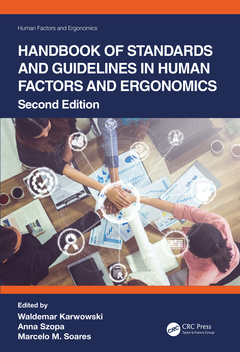Handbook of Standards and Guidelines in Human Factors and Ergonomics (2nd Ed.) Second Edition Human Factors and Ergonomics Series
Coordonnateurs : Karwowski Waldemar, Szopa Anna, Soares Marcelo M.

With an updated edition including new material in additional chapters, this one-of-a-kind handbook covers not only current standardization efforts, but also anthropometry and optimal working postures, ergonomic human computer interactions, legal protection, occupational health and safety, and military human factor principles. While delineating the crucial role that standards and guidelines play in facilitating the design of advantageous working conditions to enhance individual performance, the handbook suggests ways to expand opportunities for global economic and ergonomic development.
This book features:
- Guidance on the design of work systems including tasks, equipment, and workspaces as well as the work environment in relation to human capacities and limitations
- Emphasis on important human factors and ergonomic standards that can be utilized to improve product and process to ensure efficiency and safety
- A focus on quality control to ensure that standards are met throughout the worldwide market
SECTION I Standardization Efforts in Human Factors and Ergonomics
Chapter 1 An Overview of International Standardization Efforts in Human Factors and Ergonomics
Chapter 2 Positioning Ergonomics Standards and Standardization
Chapter 3 Ergonomic Performance Standards and Regulations—Their Scientific and Operational Basis
SECTION II Nature of HF/E Standards and Guidelines
Chapter 4 Standardization Efforts in the Fields of Human Factors and Ergonomics
Chapter 5 Overview of National and International Standards and Guidelines
Chapter 6 Balancing Stakeholder Representation: An Example of Stakeholder Involvement in Ergonomics Standardization
Chapter 7 Ergonomics Standards in Ancient China
Chapter 8 Standard in Safety Management that Takes into Account Humans’ Irrational Behavior and Decision Making
Chapter 9 The Brazilian Federal Standard Applied to Ergonomics
Chapter 10 Design in the Absence of Standards
Chapter 11 Standards of Human Factors/Ergonomics in Cuba: Theoretic-Practical Considerations Developed
SECTION III Standards for Evaluation of Working Postures
Chapter 12 Standards in Anthropometry
Chapter 13 Evaluation of Static Working Postures
Chapter 14 Evaluation of Working Postures and Movements in Relation to Machinery
Chapter 15 Standards on Physical Work: Demands in the Construction Industry
Chapter 16 Safety of Machinery—Human Physical Performance: Manual Handling of Machinery and Component Parts of Machinery
SECTION IV Standards for Manual Material Handling Tasks
Chapter 17 Repetitive Actions and Movements of the Upper Limbs
Chapter 18 Ergonomics of Manual Handling—Part 1: Lifting and Carrying
Chapter 19 Ergonomics of Manual Handling—Part 2: Pushing and Pulling
Chapter 20 Recommended Force Limits for Machinery Operation: A New Approach Reflecting User Group Characteristics
Chapter 21 Guidelines for the Prevention of WMSDs: The Italian Experience
Chapter 22 Assessment of Manual Material Handling Based on Key Indicators: German Guidelines
Chapter 23 Manual Lifting Standards: Ergonomic Assessment and Proposals for Redesign
Chapter 24 ISO Technical Report 12295: Application Document for ISO Standards on Manual Handling (ISO 11228-1, ISO 11228-2, and ISO 11228-3) and Evaluation of Static Working Postures (ISO 11226)
SECTION V Standards for Human-Computer Interaction
Chapter 25 Standards, Guidelines, and Style Guides for Human-Computer Interaction
Chapter 26 International Standards in Information and Communication Technology (ICT) Accessibility and Their Application in Operating Systems
Chapter 27 Human Factors Engineering of Computer Workstations: HFES Draft Standard for Trial Use
Chapter 28 Practical Universal Design Guidelines: A New Proposal
Chapter 29 Virtual Environment Usage Protocols
Chapter 30 Location and Arrangement of Displays and Control Actuators
Chapter 31 Maximizing the Value of Enterprise Human-Computer Interaction,Standards: Strategies and Applications
SECTION VI Management of Occupational Safety and Health
Chapter 32 The Benefits of Occupational Health and Safety Standards
Chapter 33 Occupational Health and Safety Management Systems: Trends, Analysis, and Effectiveness
Chapter 34 European Union’s Legal Standard on Risk Assessment
Chapter 35 ILO Guidelines on Occupational Safety and Health Management Systems
Chapter 36 The Selected Elements of Shaping the Occupational Health and Safety Culture in a Company Based on a Polish PN-N-18001 Standard
Chapter 37 Standards in Architectural and Building Acoustics
Chapter 38 Development of Medical Devices: Between Regulatory and Standards Requirements Versus Adopted Models
SECTION VII Safety and Legal Protection Standards
Chapter 39 Printed Warning Signs, Tags, and Labels: Their Choice, Design,and Expectation of Success
Chapter 40 Record Keeping and Statistics in Safety and Risk Management
Chapter 41 User Needs in Standards—Older People and People with Disabilities
SECTION VIII Military Human Factors Standards
Chapter 42 The Role of Human Systems Integration Standards in the Modern Department of Defense Acquisition Process
SECTION IX Sources of Human Factors and Ergonomics
Standards
Chapter 43 Sources and Bibliography of Selected Human Factors and Ergonomics Standards
Date de parution : 06-2021
17.8x25.4 cm
Thèmes de Handbook of Standards and Guidelines in Human Factors... :
Mots-clés :
Federal Aviation Administration; Worldwide market; OSH Activity; HFE standards; FAA; Quality control; OSH Policy; Human factors; ILO Guideline; Ergonomic standards; Duration Multiplier; Manual Materials Handling; HCI Standard; Visual Display Terminals; Flat Panel Displays; Oh Management System; Lifting Index; Oh Regulation; Oh Management; Manual Handling; Health Administration; Manual Lifting; Lifting Tasks; Oh Risk; Oh Legislation; Safety Management System; OCRA Index; Manual Material Handling Tasks; OCRA



